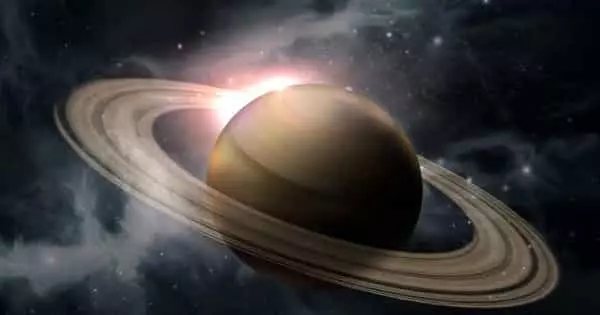With an equatorial diameter of 1,19,300 kilometers, Saturn is the sixth planet from the Sun and the second-largest in the solar system. The Voyager explorations in 1980-81 provided much of what we know about the planet. Saturn’s poles are visibly flattened as a result of the planet’s extremely fast rotation on its axis. Its day lasts 10 hours and 39 minutes, and it takes 29.5 Earth years to orbit the Sun. The atmosphere is mostly made up of hydrogen, with trace amounts of helium and methane. Saturn is the only planet with a density less than that of water (about 30% less). Saturn’s hazy yellow hue is characterized by broad atmospheric banding that is similar to, but fainter than that found on Jupiter.’
On Saturn, the wind is extremely strong. It can reach speeds of 500 meters per second near the equator (1,100 miles an hour). The wind is mostly blowing from the east. The strongest winds are found near the equator, and velocity decreases uniformly as latitude increases. Winds alternate east and west as latitude increases above 35 degrees latitude.
Saturn’s ring system elevates the planet to the status of one of the most beautiful objects in the solar system. The rings are divided into several sections, including the bright A and B rings and a fainter C ring. The main rings, as discovered by space probes, are actually made up of a large number of narrow ringlets. The rings’ origin is unknown. The rings are thought to have formed from larger moons that were shattered by comet and meteorite impacts. The Voyagers discovered radial, spoke-like features in the broad B-ring. The features are thought to be made up of fine, dust-size particles. In the Voyagers’ time-lapse images, the spokes could be seen forming and dissipating.
Saturn has 18 named satellites and over a dozen newly reported satellites with provisional designations until they are verified and named. On May 22, 1995, NASA’s Hubble Space Telescope captured Saturn’s magnificent ring system as it turned edge-on, in one of nature’s most dramatic examples of “now you see them, now you don’t.” When the Earth passes through Saturn’s ring plane every 15 years, it crosses the ring plane.
Because the rings’ edges reflect sunlight, they do not completely disappear. The dark band across the middle of Saturn is the planet’s shadow cast by the rings (the Sun is almost 3 degrees above the ring plane.) The bright stripe directly above the ring shadow is caused by sunlight reflected off Saturn’s rings into its atmosphere.
The Hubble Space Telescope captured this image of a rare storm that appears as a white arrowhead-shaped feature near the planet’s equator. Similar to a terrestrial thunderhead, the storm is caused by an upwelling of warmer air. The Hubble images are clear enough to see that Saturn’s prevailing winds form a dark “wedge” that eats into the bright central cloud’s western (left) side. The planet’s strongest eastward winds, estimated to be 1,600 kilometers (1,000 miles) per hour based on Voyager spacecraft images taken in 1980-81, are located at the wedge’s latitude. The white clouds in the storm are ammonia ice crystals formed when an upward flow of warmer gases pushes its way through Saturn’s frigid cloud tops.
The top image shows the Hubble Space Telescope’s first-ever image of bright aurorae at Saturn’s northern and southern poles in far-ultraviolet light. Hubble resolves a luminous, circular band centered on the north pole, where an enormous auroral curtain rises up to 2,000 kilometers (1,200 miles) above the cloud tops.
In comparison, the bottom image is a visible-light color composite of Saturn as seen by Hubble on December 1, 1994, demonstrating that, unlike the ultraviolet image, Saturn’s familiar atmospheric belts and zones are clearly visible. The lower cloud deck is not visible at UV wavelengths because sunlight is reflected from higher in the atmosphere.
Last View of Saturn:
Voyager-1 returned to Saturn from a distance of more than 5.0 million kilometers two days after its encounter with the planet (3.0 million miles). Because the earth is so close to the Sun, only the sunlit face of Saturn can be seen in this view of Saturn.
Saturn has 18 satellites that have been officially identified and named. There are also other unconfirmed satellites. One circle is in Dione’s orbit, another is between Tethys and Dione’s orbits, and a third is between Dione and Rhea’s orbits. The unconfirmed satellites were discovered in Voyager images but were not confirmed by more than one sighting. The Hubble Space Telescope recently captured images of four objects that could be new moons.
There are several generalizations that can be made about Saturn’s satellites. Titan is the only planet with a discernible atmosphere. The majority of the satellites rotate synchronously. Hyperion, which has a chaotic orbit, and Phoebe are the exceptions. Saturn has a regular satellite system. In other words, the satellites have nearly circular orbits and are located in the equatorial plane. Iapetus and Phoebe are the two exceptions. A lot of Saturn probe work remains to be done; nothing certain can be said about Saturn at this time, but a mystery is being revealed. What appeared to be impossible is now on the verge of being solved.
















